A statue that represented the physical manifestation of student revolution, an 18th-century satirical print that chastised the British navy, and the University of Oregon’s sexual assault prevention program were among the subjects in this year’s Graduate Student Research Forum.
Fifteen graduate students from the School of Architecture and Allied Arts—across disciplines including architecture, art history, historic preservation and nonprofit management—shared their final research during the seventh annual forum at the Ford Alumni Center on February 26.
More than 100 graduate students from around the University of Oregon shared the results of their exhaustive research work with peers, professionals, and professors during the event.
This year’s themes included:
- Crossing Borders, Crossing Cultures, Crossing Frontiers: Language, migration, identity, and the synthesis of cultures
- Breaking New Ground in the Sciences: Approaches to reproducibility and data management, shifting paradigms, and innovative research practices
- Challenges for a New Generation of Leaders: Policy, scientific, and social approaches to emerging and continuing catastrophes
- In Our Own Backyard: Pacific Northwest life, research and education, community and philanthropy
The A&AA departments represented and the students who presented research included:
Department of Architecture
Tanvi Dhar—"Comparing Environmental Performance and Indoor Comfort of LEED Certified and Conventional schools in Houston, Texas, USA"
Since the US Green Building Council created the Leadership in Energy and Environmental Design (LEED) benchmark, few studies have been conducted to investigate a “claimed improved performance of LEED schools,” according to Dhar’s research project abstract.
To investigate this disparity, Dhar studied post-occupancy evaluation of LEED-certified schools in the Houston Independent School District, which lacks research on their buildings’ environmental impact and indoor comfort compared to other locations in the country.
The effort behind LEED certification is sometimes lost, says Dhar. Architects and clients can try to acquire credits that are easier for building design implementation while ignoring measures that can legitimately help building efficiency and occupant satisfaction.
Part of the inspiration for selecting Houston, Dhar says, was to add to the body of knowledge and understanding of sustainable school performances in the southern US.
“Not many people are aware of this disparity, and the literature review suggests that LEED credits are often used as a stamp for point-chasing rather than using credits for building efficiency and occupant comfort,” says Dhar.
Dhar cites her thesis adviser, Associate Professor Ihab Elzeyadi, in the Department of Architecture, who worked on similar studies for elementary schools in the Pacific Northwest and California. Dhar’s research complements Elzeyadi’s by focusing on a case study within the hot and humid climate of Houston.
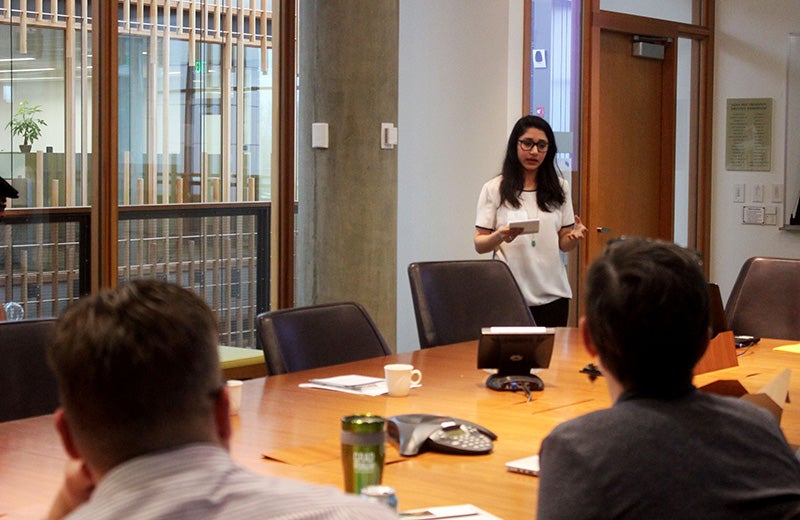
Above: Architecture major Tanvi Dhar’s research aims was to add to the body of knowledge and understanding of sustainable school performance.
Lyndsey Deaton—"Tiny-House Communities as a Response to Homelessness: Spatial Patterns that Support Community Cohesion”
When Deaton moved to Eugene, she joined a consortium of architects commissioned to design and build homes for Emerald Village, a micro-home community created for residents in need of affordable, permanent housing. She is currently working with Christina Bollo, a UO adjunct architecture instructor, to design and build a prototype home at Emerald Village.
Deaton expanded her role as architect for the Emerald Village micro-home into a comprehensive research project after she realized there were more benefits to a micro-home community than a roof over one’s head.
“We are providing rapid and inexpensive housing solutions to get people off of the street. But the innovation of a micro-home community is the much less tangible opportunity for social relations,” says Deaton.
Through interviews, site analysis, and observations, Deaton, a PhD candidate, is attempting to identify spatial patterns that support community cohesion in American micro-home communities. Of the communities surveyed, Community First in Austin (Texas), Dignity Village in Portland (Oregon), and Opportunity Village in Eugene were selected based on typological diversity, number of dwellings, and length of operation.
“It’s been an amazing opportunity to learn and contribute to the development of communities that will better meet residents’ needs,” said Deaton.
One example of a spatial pattern within these communities would be a front porch—a semi-public area that encourages neighbors to talk with one another—versus a direct entry into a home, which would force neighbors to stand or sit in the street to communicate.
Community First founder Alan Graham established a stone monument in the center of a garden within the community as a place to remember the deceased. The idea of a memorial for remembrance as a spatial pattern within a community resonated with Deaton, as she realized the chronically homeless often do not have family relationships to carry on their memory.
“I hadn’t considered the need to be remembered as an integral part of community cohesion,” says Deaton. “Alan was able to discern this through his thirty-plus years of mission work with the homeless in Austin.”
Despite numerous studies on improving living conditions through health, infrastructure, and participatory design, spatial analysis from an architectural perspective is relatively new to the study of informality. Deaton believes research on spatial patterns, typologies, and urban design are opportunities to fortify the social framework within tiny-house communities.
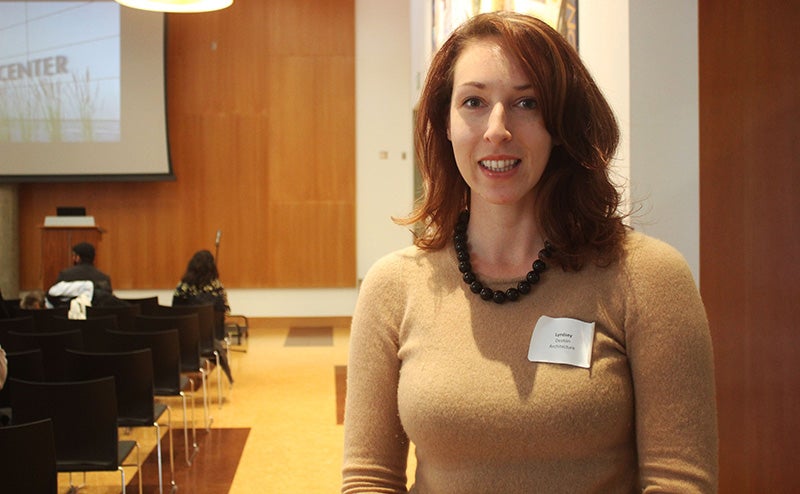
Above: Architecture major Lyndsey Deaton is studying tiny-house communities as a response to homelessness.
Alyssa Franco and Nicolette Stauffer—"The Feasibility of Zero Emission Residential Design"
Graduate students Franco and Stauffer are both working on a research project about the practicality of “green” architecture design in the Western United States.
“Energy required to operate even a small family residence is dependent on the lifestyle of the user,” says Stauffer. “This case study assumed a best-case scenario, which is a family that makes environmentally conscious decisions.”
Using Eugene, Denver (Colorado), and Spokane (Washington) as case study locations, Franco and Stauffer tested different carbon-neutral residences. The different climates in these locales —including varying temperatures, wind patterns, and sun angles—demanded small modifications in the home designs for ventilation strategies, including shading and floor-to-glazing ratio.
“According to our case studies, zero emission design that takes into account building materials is certainly feasible,” says Stauffer. “However there is still a lot of research to be done.”
Their project focuses on the “low-tech” side of sustainable building through local materials and passive design strategies. The original location of materials used in residential design plays a key role in considering how “green” a house is; the more locally sourced the materials, the fewer carbon emissions that would be released, since all materials require transport. Stauffer and Franco found that the Pacific Northwest has a relatively clean energy production in terms of emissions compared to other locations in the country.
Stauffer adds that working with professionals in energy study fields would yield more specific and accurate answers to the feasibility of green design in this research.
Stauffer and Franco credit their third research partner, Michelle Lalonde, for being “an integral part” in the initial design process during a zero-emission building studio last spring.
This research was based on a built project from Norwegian firm Snøhetta, for which visiting professor Tine Hegli works as senior architect. Snøhetta’s original zero-emission building project researched material emissions and occupant energy use, which was balanced with solar energy production.
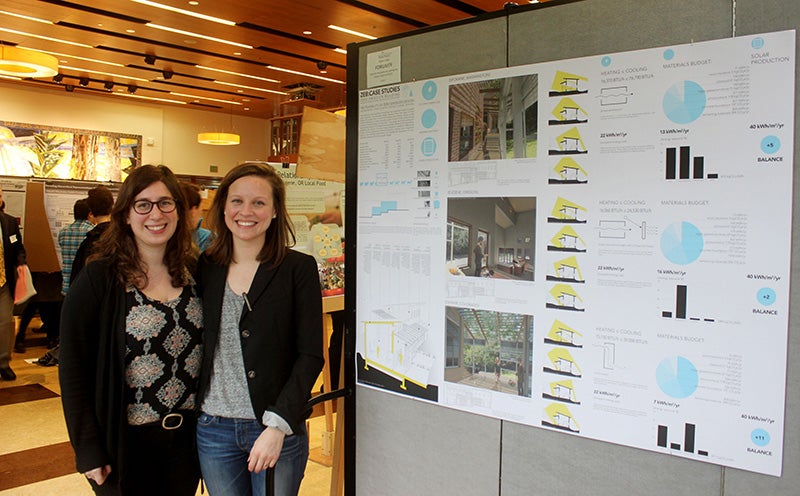
Above: Architecture majors Alyssa Franco and Nicolette Stauffer are studying the practicality of “green” architecture design in the Western United States.
James Miller—"Adapting to Climate Change: Land-use and Building Practices in the Marshall Islands"
Following the 2010 Haiti earthquake, Miller developed an interest in post-disaster reconstruction and the effects of climate change on low-lying nations and coastal communities.
Miller’s interest in post-disaster redevelopment projects dovetailed into the implications of climate change and rising sea levels on small coral atoll nations, or islets, in the Pacific Ocean. Miller believes the Marshall Islands represent a particularly poignant case study for this research because as low-lying corals, the country is already feeling the effects of climate change.
Miller’s research focuses on the evolution of land use on the Marshall Islands regarding the climate’s effect on the region, and how building plans can benefit future urban development on the islands.
“I believe that it is necessary to understand the evolution of the relationship between culture and the built environment of a place in order to prepare and sort resettlement plans,” says Miller. “Understanding the underlying patterns of this relationship will help predict how regeneration might occur.”
While researching the islands, Miller wondered why it is uncommon for a house to be raised above the ground to provide protection from high tides. He found that regardless of a house’s built height, a flood will ruin the livelihood of home’s residents because the flood’s encroachment on land devastates the ability to grow crops.
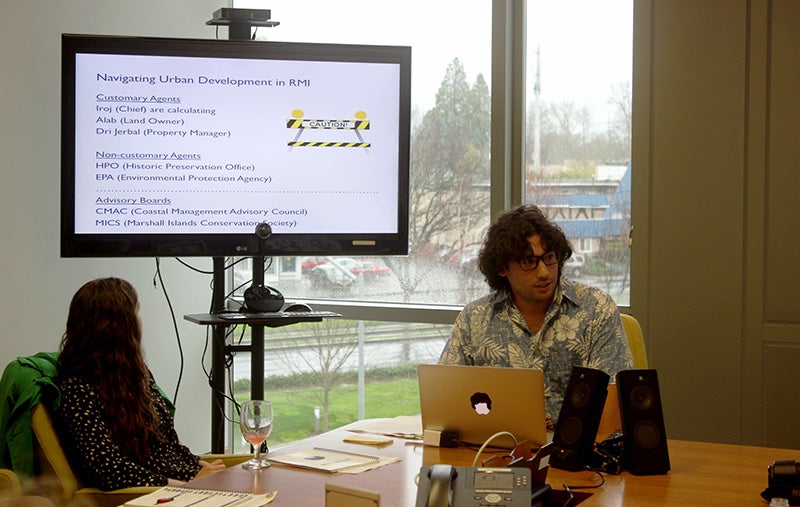
Above: Architecture major James Miller is interested in post-disaster redevelopment and the effects of climate change on low-lying communities.
Arts and Administration Program
Halley Perry—"Informal Art Education Curriculum Accessible for Students With Autism"
Perry works as volunteer for the UO’s Jordan Schnitzer Museum of Art’s VSA program (formally known as Very Special Arts), which spurred her research project on informal art education for students with autism. The VSA program is a free art studio workshop that allows hands-on art production for K-12 children with disabilities.
“I immediately got hooked to helping students with autism,” says Perry. “The reaction of these children creating their own works of art has been one of the most fulfilling and rewarding opportunities. It was soon after that I decided to pursue a career that combined art and healing.”
Promoting the program is the most important element to the research, Perry says, since many families don’t know of its existence. The secondary element to the research is the cognitive, social, and emotional development that art education can provide to children.
“Our culture tends to focus on if answers are wrong or right. Art allows us to see different ways of solving problems,” says Perry.
Art can promote emotional benefits by fostering self-expression, Perry says. Its creation can help many artists cope with emotional pain.
“It is my hope that my research can be used as a quick understanding how curriculum can be different for children with autism,” says Perry, whose research focuses on the JSMA and the Denver Art Museum as case studies.
Perry picked these two museums for their similar size, visitor demographics, art activities, and funding sources. These well-being programs are continuously increasing in popularity at museums across the country, she says.

Above: Arts management major Halley Perry is researching how to make informal art education more accessible to students with autism.
Historic Preservation Program
Rodney Bohner—"Historical Coastal Landscapes: Historic Preservation and Waterfront Redevelopment"
A year before he started studying historic preservation at the UO, Bohner spent a year living and working aboard a historic sailing vessel along the Eastern Seaboard. The boat’s occupants worked with at-risk youths from inner-city neighborhoods.
“It was an eye-opening experience that solidified my desire for a career working to improve communities while highlighting working-class, historic resources,” Bohner says.
For this project, he is studying the challenges faced by Oregon coastal and river communities as rising sea levels threaten to erase the historical features and heritage of these coastal areas.
By identifying the role of historic preservation along urban waterfronts, Bohner says his research will help preserve the authentic heritage of each community.
“I feel that my research will help identify deficiencies in current historic preservation planning while addressing clear benefits as well as examples of how to effectively and responsibly use those resources tied to Oregon’s maritime heritage.”
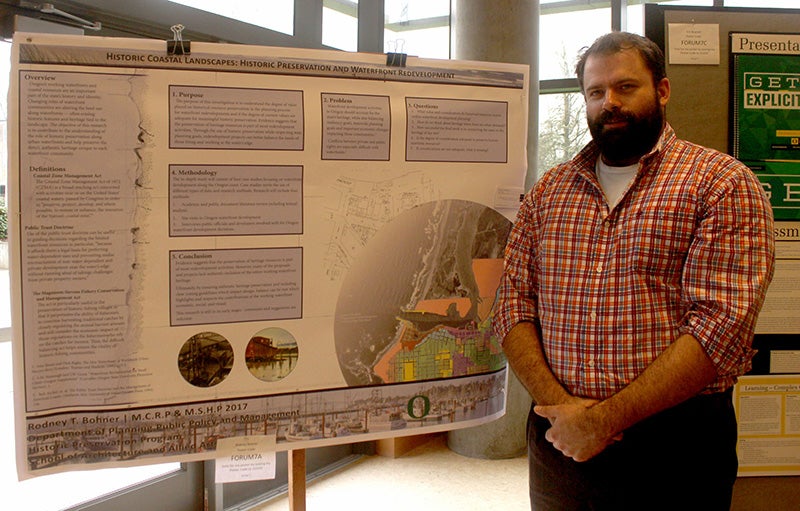
Above: Historic preservation major Rodney Bohner is studying the challenges faced by coastal and river communities as rising sea levels threaten to erase historical features.
Rachelle Byarlay—"Early Glulam: A History of Glued-Laminated Timber Manufactured Prior to 1963, Its Deterioration, and Its Preservation"
Byarlay looks to the history of glued-laminated timber, also called “glulam,” as a structural building material. Manufactured by gluing pieces of lumber together, glulam came to the US in 1934 and became more popular following World War II. Its growth in popularity was partially prompted by the need for open long-span structures, like airplane hangars.
Byarlay’s fascination with glulam was prompted when she enrolled in the historic preservation course AAAP 510: “Building Pathology—Wood,” taught by Instructor Suzana Radivojevic. The course, which discussed the structure of wood, its decay mechanisms, and preservation in the context of buildings, required Byarlay to write a short paper about plywood, an engineered wood product made from layers of wood and glue, much like glulam.
While plenty of information and research on solid wood as a building material exists, relatively little exists about engineered wood products such as glulam, says Byarlay, whose research investigates and compiles repair and preservation practices that comply with federal preservation standards.
Extant glulam buildings and structures built prior to 1963, being more than fifty years old, are eligible for listing in the National Register of Historic Places.
“It is my goal that through my research I can develop a document on glulam preservation that resembles a Preservation Brief,” says Byarlay.
Preservation Briefs are technical guides, published by the National Park Service, for the preservation, rehabilitation, or restoration of historic buildings and structures. No Preservation Brief has been published yet on glulam, Byarlay says.
While wood can become prone to decay from fungi or insects when it becomes moist, the glue between the layers of wood in glulam can serve as a barrier, and the decay can be confined to specific layers.
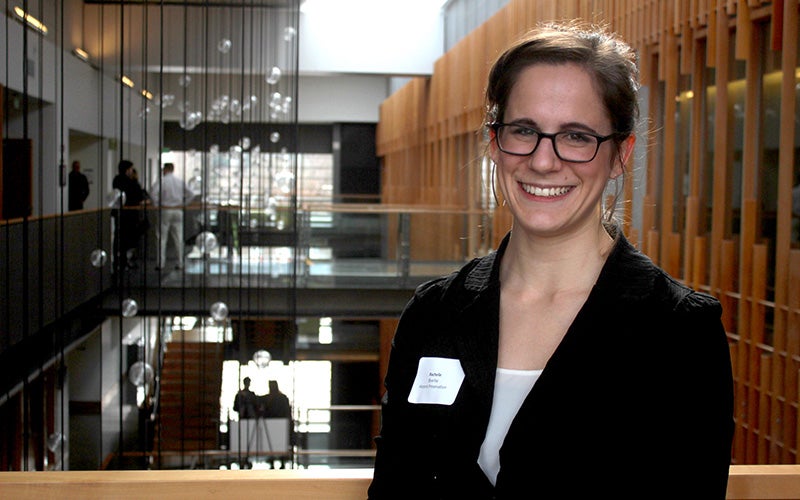
Above: Historic preservation major Rachelle Byarlay’s research focuses on glulam, a structural building material.
Department of the History of Art and Architecture
Chyna Bounds—"Behind the Irony: a Reevaluation of James Gillray's Fictive Monument 'Design for Naval Pillar'"
Bounds focused her master’s thesis on the painting “Design for Naval Pillar” from British satirical printmaker James Gillray, whose works subtly critiqued both the British and French governments.
Bounds, who discovered Gillray’s works while an undergraduate at the University of Minnesota, says that “Design for Naval Pillar” is highly unusual, compared to the rest of his works. While it was originally considered to be a piece that glorified the British Navy’s victory, Bounds argues that Gillray’s motifs within the print, contrarily, allude to a tongue-in-cheek criticism under an ironic veneer of British patriotism.
“Upon first look it exudes a very pro-Britain message that is an anomaly to Gillray’s work—the bulk of his prints criticize various members of the government,” she says. “Because of the strangeness of this overt glorification of Britain, I began going through Gillray’s oeuvre and found other images, done around the same time, which featured very similar motifs as the shaft of the pillar in ‘Design for Naval Pillar.’ ”
Since there is little written about Gillray’s print or fictive monuments in art historical scholarship, Bounds says her research will recategorize this print, as well as a work by British caricaturist George Cruikshank, to better understand the caricaturists’ attitudes toward the British and French governments.
“My thesis as a whole also redefines the fictive monument, and argues that actual monuments in satirical prints become fictionalized by the satirical additions to them,” she says.
Bounds, student liaison for the Jordan Schnitzer Museum of Art’s Collections Committee, recently curated an exhibition at the JSMA around European satirical prints from 1750-1850 titled “Contemplation & Confrontation,” which included a print from Gillray as well as works from Francisco Goya, William Hogarth, and other European satirists infamous for lambasting political figures and challenging the status quo.
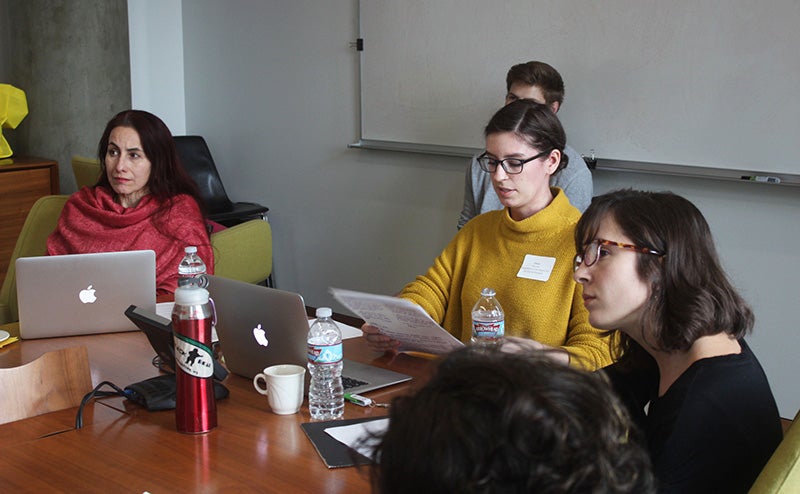
Above: Art history major Chyna Bounds, at center, focused her master’s thesis on the painting “Design for Naval Pillar” by a British satirical printmaker. All photos by Emerson Malone.
Kun Xie—"The Goddess of Democracy and the Tiananmen Protest: An Instrument of Declaration, Demonstration, and Unification"
Chinese student protests at Tiananmen Square in 1989 decried the Communist party’s handling of the economy, and called for a change to a democratic system. During the protest, students constructed a 33-foot statue in four days, using foam and papier-mâché. The statue portrayed a woman posing with a Statue of Liberty-like gesture.
When the government forcefully intervened and soldiers cleared protestors from the public square, the statue was destroyed. Despite its ruin, when the statue was initially unveiled, it included a declaration that it would be erected once democracy arrives in mainland China.
The statue, a visual manifestation of the students’ resolve for democracy, is the central focus of research by art history graduate student Xie’s research, which looks at the original statue and its visual-cultural background, and uses the figure as a way to contextualize the Tiananmen Square student protects as a whole.
Xie’s research began in a “Theories and Methodologies” course, taught by history of art and architecture Assistant Professor Kristen Seaman.
Despite the rich scholarship on the Tiananmen Protest itself, Xie says that a complete analysis of the Goddess statue alone is hard to find.
“Through researching more into the Goddess of Democracy and Tiananmen Protest, you will find things will get extremely complicated,” says Xie. “As [Renaissance author] Baldassare Castiglione wrote in the very end of The Book of the Courtier, none of us will ever be able to reach the truth, but simply approach it through discourse.”

Above: Art history major Kun Xie’s research is titled "The Goddess of Democracy and the Tiananmen Protest: An Instrument of Declaration, Demonstration, and Unification."
Department of Planning, Public Policy and Management
Eric Braman, nonprofit management—"Get Explicit 101: Educating First Year Students on Sexual Violence Prevention and Education"
Braman, a graduate teaching fellow for the UO’s Sexual Violence Prevention and Education office, focused his research on the effectiveness of “Get Explicit 101,” a UO-based program to educate first-year college students about sexual consent, bystander intervention, and healthy sexual practices.
By studying survey results received from students at the course’s start and end, Braman plans to use the data to better understand the effectiveness of the course’s curriculum on its participants.
Students were surveyed on different scenarios to rank how likely he or she was to engage in a certain type of behavior. Braman’s statistical assessment of these answers found a “statistically significant, substantial increase” in students’ likelihood to intervene in problematic situations during post-workshop assessment compared to answers collected pre-workshop.
“Right now there is a lot of focus across the nation about making sure that universities are doing everything they can do to prevent sexual violence,” says Braman. “This assessment tool allowed us to consider willingness, which is a first step toward someone actually going out and changing the environment across campus.”
By focusing on first-year students, Braman hopes that by the end of a student’s four-year undergraduate experience, he or she will have engaged in an extensive conversation and learning experience on this topic. He says more than 80 percent of UO students will have an interactive training session about sexual assault and violence prevention by the end of their four years through programs like Get Explicit and others.
The program is intended to be first of many for students to focus on consent and healthy sexuality at the UO.
“Seeing the gains and losses of this initial program roll out will be instrumental in helping the office design future programs to premiere on campus in the years to come,” says Braman.
“The program’s emphasis on calling out perpetrator behavior, encouraging open conversations about healthy sexuality, and providing a call-to-action for bystander intervention is what, I think, will be of most value to the national conversation,” he says.
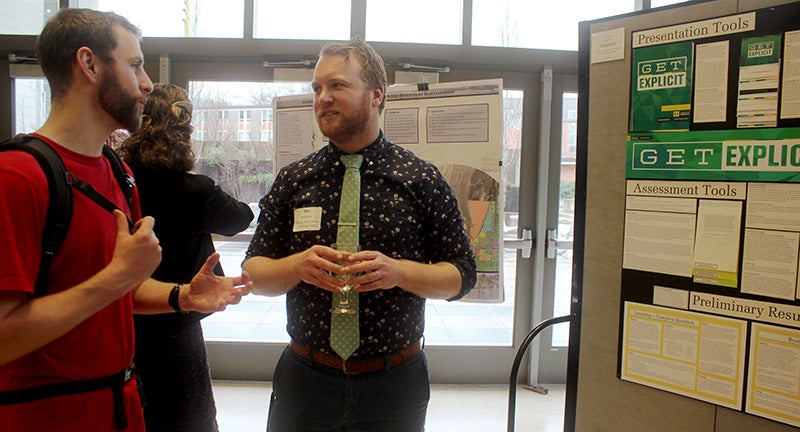
Above: Nonprofit management major Eric Braman is focusing on the effectiveness of a program to educate first-year college students about healthy sexual practices.
Emily Brown, community and regional planning—“Overcoming the Barriers to Micro-housing"
Opportunity Village Eugene, a micro-home community that provides shelter in the form of modest-sized, independently standing homes to those experiencing homelessness, was part of the inspiration for Brown’s research on the barriers that inhibit these communities from being replicated more extensively throughout the country.
Brown conducted an evaluation of Opportunity Village and the Rest Stop Pilot Program last year. Learning about the City of Eugene’s initiatives to supply those experiencing homelessness with shelter and allow them to camp in legally designated sites and shelters motivated Brown to continue studying micro-housing.
The department helped Brown secure funding that allowed her to travel to Washington state to visit Quixote Village.
Further research led Brown to learn about city zoning barriers and other obstacles that prevent widespread implementation. Disapproval of these communities, Brown says, comes from conjecture that micro-house communities may lower property values or bring crime to a neighborhood.
“There is a lot of social stigma around low-income housing and homelessness that makes people fearful of what they don’t know,” says Brown. “Luckily, success stories like Opportunity Village Eugene are prompting other communities across the United States to pursue this model.”
Additionally, other issues—like the inability to insure one’s micro-home or connect it to electricity and water—have introduced Brown to alternative solutions, such as a Portland-based insurance company that specializes in micro-homes, or various tiny home residents who rely on solar panels, rain retention methods, or hand-crank washing machines to be self-sufficient.
Brown interviewed residents of micro-homes across the country, including people in Iowa, Maryland, New York, Texas, Washington, Colorado, Michigan, North Carolina, and Virginia.
“What I initially thought was a new and relatively limited movement is actually booming and popular all across the country,” she says.
Brown found that although micro-housing is widely discussed online on social media outlets like Pinterest and Facebook, the discussion about these villages borders on a whimsical appreciation of their aesthetic value.
“Yes, they are adorable,” Brown says, “but they are also a really viable source of affordable housing.”
Brown says her research aims to consolidate a list of strategies that will allow people who want to live in micro-housing communities to overcome these impediments and to expedite their implementation.
“My hope is to continue a conversation about how micro-housing fits along the spectrum of solutions to homelessness and a lack of affordable housing,” she says.

Above: Community and regional planning major Emily Brown is investigating how to overcome barriers to micro-housing.
Rory Isbell, community and regional planning—"Follow the Money: Effectiveness of Climate Goals in Shaping Transportation Spending"
Isbell looks to explain the discrepancy between climate-related goals set by various levels of government and the funding devoted to transportation infrastructure projects to achieve those climate goals.
“Governments often make broad policy statements or aspirational goals, but they don’t always implement the means to reach those goals,” says Isbell.
Isbell, a dual degree graduate student in law and community and regional planning, says that this research will add to other scholarship on government transparency and accountability.
“I am interested in the ability of legal enforcement mechanisms to hold governments accountable to these climate goals,” he says. “This research is fueled by the urgency of climate change mitigation and the need for our governments to be accountable in meeting climate goals.”
An example of a regional government’s climate-related goal is the long-term initiative of the San Francisco Bay Area’s regional transportation agency, Metropolitan Transportation Commission (MTC), the first goal of which is “climate protection.”
Thirteen states in the US have called for reducing greenhouse gas emissions, including California, which has stated a goal of reducing economy-wide emissions to 80 percent below 1990 levels by 2050. Washington, California, and Massachusetts—Isbell’s three state case studies—all have similar statewide climate goals.
Isbell says this research was born from a previous research project that focused on the relationship between climate goals and land use and transportation policies in four US states.
Isbell expects to complete his research by fall 2016. The National Institute for Transportation and Communities funded the project.

Above: Community and regional planning major Rory Isbell is researching the effectiveness of climate goals in shaping transportation spending.
Eren Kavvas, nonprofit management—"Share the Knowledge: Management Research from the Private Sector to the Service-Oriented Sector"
For this research project, Kavvas investigated the disparity between academic journals and nonprofit professional publications, the latter of which includes news and public statements. Kavvas conducted a comparative, statistical analysis to test an assumption that knowledge was not dissipating properly between the two texts. Kavvas hypothesizes that practicing nonprofit publications fail to be aware of the surfeit of information available to them.
“I became convinced that if knowledge from academia were able to successfully trickle down to professional nonprofits that these organizations would run much better,” says Kavvas, a nonprofit management student.
If one goal of academia is to use knowledge to positively impact the world, understanding how that knowledge makes this impact is intrinsic to the objective, says Kavvas.
She added, “By seeing if and in what capacity knowledge has moved from academia to the professional practice, I believe I add to the scholarship by giving the lens of meta-analysis and synthesis of the existing information.”
Kavvas says that exploring the data has been particularly shocking; in their respective topic studies, nonprofit publications focused on mission and community, and academic journals were focused on financials and business elements.
“I do not doubt that the collection of knowledge is an end to a means in and of itself, I also want to challenge people to see how their research impacts the world outside of the ivory tower,” says Kavvas. “Understanding how our research can benefit the world on a practical level is something for which we should also strive.”
More information on the forum can be found at gradforum.uoregon.edu.
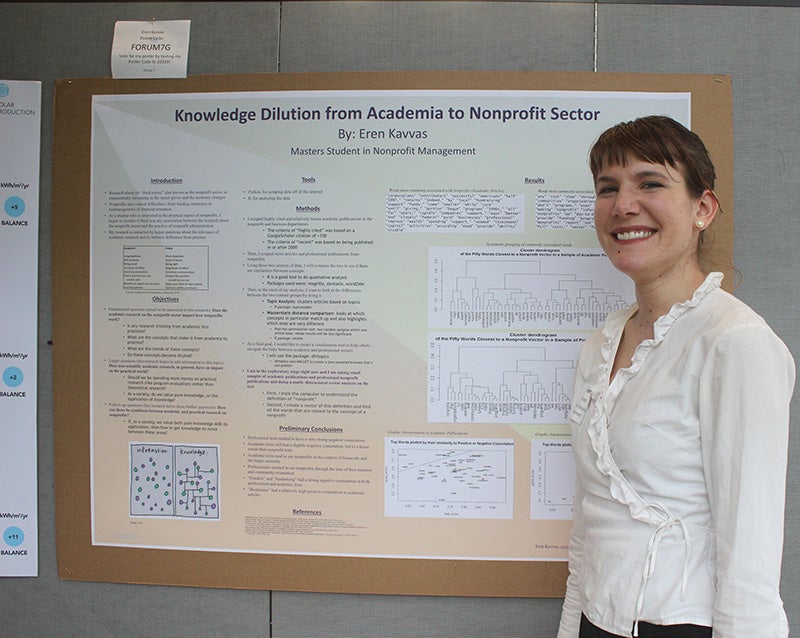
Above: Nonprofit management major Eren Kavvas investigated the disparity between academic journals and nonprofit professional publications.
